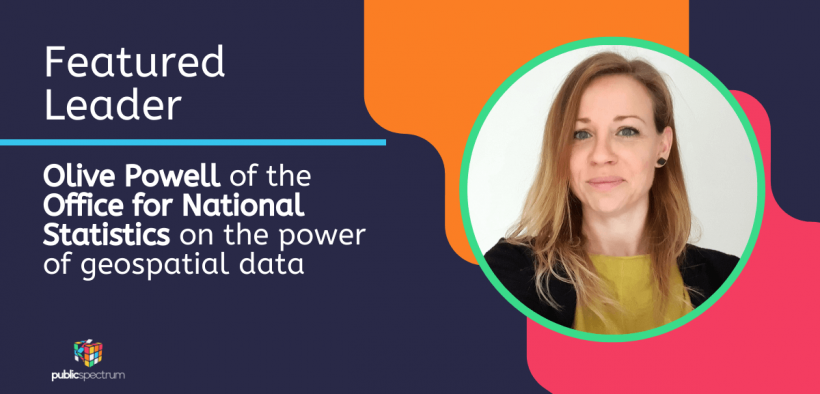Olive Powell of the Office for National Statistics on the power of geospatial data
Share

I have been working in the geospatial industry for more than twenty years and my passion for geospatial is still as vibrant as the day I discovered it. I spent most of my operational career demonstrating its value and trying to convince others to pay more attention to it. I was convinced that it was going to dramatically improve how we live and work.
Owing to the pandemic and the increasing number of challenges the world faces, awareness of the use cases for geospatial data has increased. We are reaching a consensus that the continued expansion of geospatial capability is needed to understand and respond to key challenges, such as rising food and fuel prices and efforts to achieve net zero and adapt to climate change.
Growth in Geospatial availability and appetite
Since joining the Civil Service in 2020 I have gained a more strategic and global understanding of the value and potential of geospatial data. The greater “three-dimensional” insight that geospatial data provides was self-evident during the government’s pandemic response. And its added value, compared to traditional data, has led to fast growth in both interest and demand.
The increasing availability of faster data sources, such as earth observations and mobility data, is unlocking the potential for us to analyse and understand issues previously considered too complex for us to approach, building new use cases and demonstrating the value of geospatial data.
At a national level, and indeed around the world, the pandemic sparked a greater need for spatial data to inform central government policies. In the UK, the ONS’ geospatial division was flooded with data requests like never before.
The team were busy pulling together and publishing geospatial datasets, tools and analysis on a weekly basis, from the creation of new reporting geographies and the generation of postcode lookups for the NHS COVID-19 mobile app, to matching addresses that enabled the production of statistics on the spread of infection and assessing the best location for wastewater sampling.
The team was also instrumental in performing bespoke and complex spatial analysis, such as the analysis looking at clusters of deaths involving COVID-19 across time and areas in England and Wales. Despite joining ONS after its pandemic response, I am grateful to have inherited such a fantastic and talented geospatial team and reflect proudly on their achievements during this time.
Need for better collaboration and data integration
Data from a single source is no longer enough. With ever more complex issues to solve there is a greater focus on the integration of data assets. I believe “geography” is a common language that enables the integration of information from various sources.
Before joining the ONS I led the international team at the Geospatial Commission in Cabinet Office. I witnessed the international community’s interest in geospatial grow steadily with the global uptake of multilateral geospatial frameworks such as the United Nations’ Integrated Geospatial Information Framework (IGIF), developed by the UN’s Committee of Experts for the Global Geospatial Information Management (UN-GGIM). These frameworks help nations implement or enhance their geospatial data structures and systems nationally, laying strong foundations for further integrations between various data sources.
There is an increasing need for collaboration and data sharing between organisations and government departments and a “system of systems” is now being discussed – the “Geospatial Knowledge Infrastructure” for instance – where technology allows for data to flow within various geospatial ecosystems, providing the opportunity to pull disparate datasets together in a single context to produce a bigger picture.
Geography at the heart of collaboration and data integration
The ONS’ geography and geospatial services aim to facilitate the sharing and integration of data to improve analytical capability. To harness the power of “geography” as a common language the ONS is putting location data, such as addresses and geographies, at the heart of the data integration process.
Location is being embedded within the development of a comprehensive data management solution called the Reference Data Management Framework (RDMF). This framework allows for the vast volume and variety of data that we increasingly handle to be processed, managed, and linked through five key referencing indexes, including its two central and pivotal indexes: the Address Index and the Geography Index. This will maximise the benefit of the standardisation, transparency, and consistency of data.
Working in collaboration with partners across government, each of the four UK nations and the external research community, ONS is leading the delivery of an ambitious cloud-based collaborative platform: the Integrated Data Service (IDS).
This new cross-government initiative, designed to transform the way de-identified data about our society and economy is made available for vital research and decision-making in the UK, will provide accredited researchers and analysts with a secure platform to conduct complex analyses and work collaboratively on the issues of the day. Using frameworks such as RDMF, the IDS will link a wide range of datasets and create themed data assets relating to key government priorities, including the achievement of net zero, public health and regional growth.
Currently operating in a beta phase, the IDS will provide coordinated access to high-quality and improved forms of data, alongside analytical and visualisation tools, in a secure multi-cloud infrastructure. This is moving us away from a model that involves waiting for a project to emerge and then rushing around to try to get the data for it towards a recognition that critical national data assets should be made readily available, so we can answer questions that we don’t yet know we need to answer.
It’s exciting to see ONS explore new avenues for better data to help solve the challenges we face, and for my team to guide where geospatial data has a critical role to play. I look forward to our continuing work with the Ordinance Survey, the UK national mapping agency, and other key stakeholders as we further the integration of geospatial and statistical data and improve its assimilation within our systems.
Geospatial data is here to stay and there are certainly exciting times ahead.
For more insights from our Featured Leaders, click here.
Olive Powell is a chartered geographer (GIS) and fellow of the Royal Geographical Society with IBG with over 20 years' experience in the use of geospatial data and technology.
She is currently heading the ONS’ Geospatial division and is responsible for aiding the delivery of the geospatial infrastructure, datasets and spatial analytical services to improve the provision of statistics for the public good.
She is passionate about diversity and geospatial, and is the co-founder and Director of Women+ in Geospatial global network.










Today’s Pick
11th Annual Aus Goverment Data Summit
April 1, 2025
7th Annual NZ Government Data Summit
May 7, 2025
3rd Public Sector Comms Week
May 14, 2025
Subscribe
We send emails,
but we do not spam
Join our mailing list to be on the front lines of healthcare , get exclusive content, and promos.
AI appointment Australia Australian boost boosts business businesses covid-19 cyber attack cybersecurity cyber security data data breach data management defence Digital employment enhance enhances fraud funding governance government grants Healthcare infrastructure Innovation Lockdown management new zealand NSW NZ online privacy public Public Sector queensland renewable energy scams security Social Media Technology telecommunications victoria
-

Understanding and building your digital strategy
Digital Government, Opinion
-

Featured Leader: Jamie Morse on multi-channel strategies for communication
Communications, Featured Leader
-

Featured Leader: Tegan Tembe of NSW Treasury on creating solid planning strategies and processes
Featured Leader
-

Wirraka Maya Health Service improves patient care with My Health Record
Learning
Show More-

Effects of ineffective communication in the workplace
Communications, Personal Development
-

7 ways you can enhance your personal development skills
News, Personal Development
-

5 advantages of working in the public sector
News, Personal Development, Professional Development
-

7 causes of communication issues in the workplace
Communications, News, Personal Development
Show MoreLast Viewed